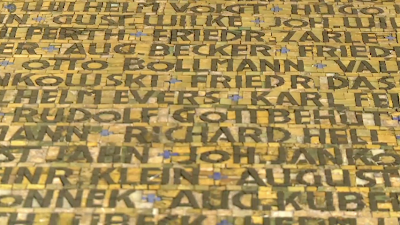
Many of the Young British Artists are concerned first and foremost with either disrupting the status quo of the British art establishment, or their own overblown self-importance. Neither concern is, in and of itself, to be scoffed at, but when there is nothing else going on, I have little patience for yet another episode of the ego vs the colonizing (in every sense of the word) super ego. Mark Wallinger engages both these familiar preoccupations in his latest installation at Anthony Reynolds in Great Marlborough Street. But unlike his now not so young British compatriots, Wallinger characteristically engages both us and the art object at deeper and more complex levels.
I am Innocent (2010) suspends two oversized reproductions of Velasquez’ superb Portrait of Pope Innocent X (1650), back to back on a rotating wire. The original Velasquez portrait now hangs in the Doria Pamphilj Gallery in the Palazzo Doria Pamphilj in Rome. Wallinger’s decision to copy the great Spanish painter runs much deeper than an admiration for this, one of the world’s most celebrated portraits. Significantly for Wallinger, whose work takes up the discourse on the reproduction of images, Velasquez himself copied the Portrait of Pope Innocent X on a number of occasions, most notably at the request of King Philip. And so, immediately, we are on guard against the use of reproduced images for the purposes of stroking the ego and filling the wallets of those in power. The fact that Wallinger’s piece comprises two reproductions of Velasquez’s portrait, and these in an infinite rotation that ensures their unrelenting display, brings us “face to face” with the marriage of convenience between art, the institution and the demands of a political economy.
Even without this history, even without knowing of Pope Innocent X’s shrewd economic and political exploits, we know enough about the corruption of the Catholic Church, and we are adequately skeptical of the “innocence” of any papal figure, of any generation, to be alerted to the irony of Wallinger’s claims in I am Innocent. And so, we meet the pope, even though he is removed via repeated reproductions of Velasquez’ representation, with skepticism and mistrust of the eyes that follow us as the double sided portrait spins on its suspended wire.

Things only got worse as I sat before the piece, patiently attempting to grasp the ever-evasive images. As I sat watching his figure go around and around, at some point, Innocent came to be watching me. Just as the eyes of one side of the portrait went out of view, so the next set appeared, taking up the surveillance of me as I became the subject of his suspicion. In keeping with Velasquez’ skill at having his figures watch our every move, the beady, unrelenting eyes of Pope Innocent X survey me without pause, no matter how much I start to shirk his look.
Thus, in direct distinction to what might be our expectation of looking at art in a gallery, Wallinger completely disrupts the viewing economy and we realize that we are the ones who are always watched and surveyed, we are the pawn in the economy of looks, and presumably in the political economy as well. Determined to get the better of Innocent, determined that he not have the last look, I masochistically kept watching him go around and around. Until, in time, I could no longer look at him, no longer see him. My look become completely denied as I began to feel dizzy, nauseous, and eventually, had to leave the gallery.
Images (c) the artist, courtesy Anthony Reynolds Gallery
I am Innocent_2010_Digital archival prints on standard fine art paper_mounted on aluminium_laminated with ultrathin semi matte laminate_electric motor_139.1x116.9x2.5cm.jpg









